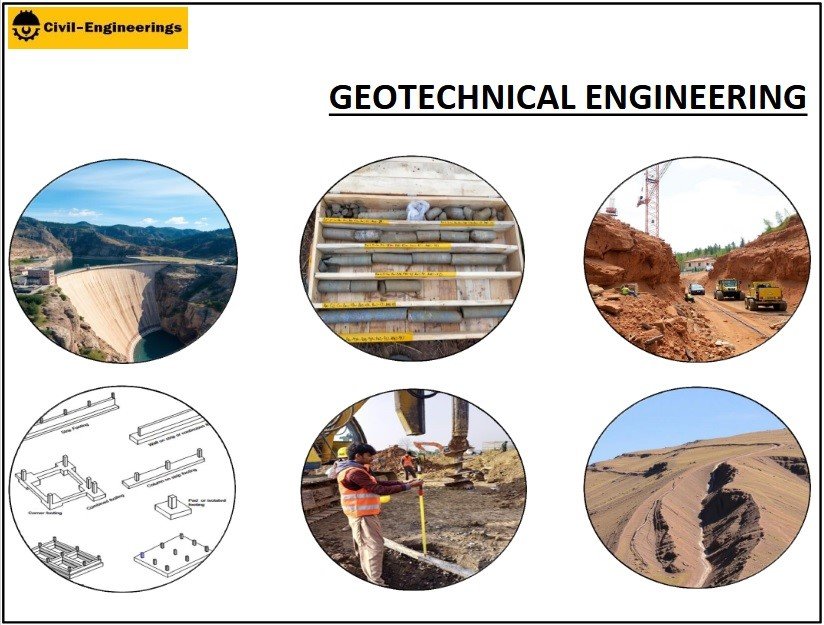Geotechnical Engineering For Construction Projects - An Overview
Not known Facts About Geotechnical Engineering For Construction Projects
Table of ContentsAn Unbiased View of Geotechnical Engineering For Construction ProjectsIndicators on Geotechnical Engineering For Construction Projects You Need To KnowGeotechnical Engineering For Construction Projects for DummiesThe 9-Second Trick For Geotechnical Engineering For Construction ProjectsThe Best Strategy To Use For Geotechnical Engineering For Construction ProjectsSee This Report about Geotechnical Engineering For Construction Projects
The role of geotechnical engineering significantly deals with recognizing the functions of soil and rock, which may vary substantially by their density, dampness content etc. These functions have to be analyzed by geotechnical designers to anticipate their activities under numerous scenarios. The safety along with security of frameworks are impacted by soil problems, making this analysis essential.A geotechnical designer will examine dirt to figure out the bearing capacity of the planet and recommend proper foundation types, such as superficial structures, deep foundations like piles, or specialized services like drifting foundations for soft soils. Recognizing the attributes and activities of soil and rock, in enhancement to how they interact with buildings that have actually been set up on or within them, is just one of the key explanations for why geotechnical engineering is very important.
Along with architectural planning and construction, geotechnical design is additionally important to the restoration and maintenance of pre-existing frameworks. Age-related destruction or added issues can impact a structure's security and efficiency. Environmental management is accomplished via geotechnical engineering. Experience in air, water, and dirt top quality maintenance is used by geotechnical designers to lessen the adverse results of tasks.
Infrastructure growth, offshore engineering, passage building and construction, and deep foundations. Risk-based design and multidisciplinary groups. These parts will certainly keep the field progressing and ensure its continued importance in the years ahead. To summarize, geotechnical design is an essential discipline that protects the durability and integrity of civil infrastructure. Geotechnical engineers contribute to making structure tasks effective around the globe by understanding the practices of earth materials and using suitable planning techniques.
The Ultimate Guide To Geotechnical Engineering For Construction Projects
The foundational security of any job is critical. Geotechnical engineering plays an important function in ensuring that frameworks are constructed on solid ground, essentially and figuratively. By examining dirt, rock, and subsurface problems, geotechnical designers give necessary insights that help in the layout, construction, and upkeep of structures and infrastructure.

7 Simple Techniques For Geotechnical Engineering For Construction Projects
Lab testing: Identifying the homes of dirt and rock. A number of high-profile building tasks have actually effectively utilized geotechnical engineering to guarantee their security and security.

As a leader in geotechnical design, BECC Inc. is committed to delivering cutting-edge and effective services that fulfill the highest possible criteria of quality and security. To learn more on how BECC Inc. can sustain your following construction task, call us today and allow us help you improve strong ground.
William Rankine, a designer and physicist, established a different to Coulomb's planet stress theory. Albert Atterberg established the clay consistency indices that are still utilized today for dirt category. In 1885, Osborne Reynolds acknowledged that shearing reasons volumetric extension of thick products and contraction of loosened granular products. Modern geotechnical design is stated to have begun in 1925 with the magazine of Erdbaumechanik by Karl von Terzaghi, a mechanical engineer and rock hound.
The Definitive Guide to Geotechnical Engineering For Construction Projects
Terzaghi additionally established the structure for concepts of birthing capability of foundations, and the concept for prediction of the price of settlement of clay layers due to loan consolidation. Later on, Maurice Biot totally created the three-dimensional dirt debt consolidation concept, expanding the one-dimensional version formerly created by Terzaghi to a lot more general hypotheses and introducing the collection of fundamental equations of Poroelasticity.
Geotechnical engineers check out and identify the buildings of subsurface problems and materials.
5 Easy Facts About Geotechnical Engineering For Construction Projects Shown
Geologic mapping and interpretation of geomorphology are typically completed in description examination with a rock hound or design geologist. Subsurface exploration normally entails in-situ screening (for example, the common infiltration examination and cone infiltration examination). The excavating of examination pits and trenching (particularly for locating faults and slide planes) may likewise be used to discover soil conditions at depth. Still, they are occasionally made use of to permit a rock hound or designer to be decreased right into the borehole for straight visual and hands-on evaluation of the dirt and rock stratigraphy. Various dirt samplers exist to meet the demands of various design tasks. The common infiltration examination, which utilizes a thick-walled split spoon sampler, is the most common directory method to gather disturbed examples.

If the interface between the mass and the base of a slope has a complex geometry, slope stability analysis is challenging and numerical remedy approaches are needed. Commonly, the user interface's precise geometry is unknown, and a streamlined user interface geometry is presumed. Limited inclines require three-dimensional designs to be evaluated, so most inclines are examined assuming that they are definitely vast and can be represented by two-dimensional versions.
What Does Geotechnical Engineering For Construction Projects Do?
The empirical approach might be referred to as complies with: General exploration adequate to develop the harsh nature, pattern, and residential or commercial properties of deposits. Evaluation of the most likely problems and the most undesirable imaginable inconsistencies. Developing the layout based on a working theory of actions prepared for under the most possible conditions. Choice of quantities to be observed as building earnings and determining their anticipated worths based upon the functioning theory under the most negative problems.
Measurement of amounts and evaluation of actual problems. It is inappropriate for projects whose style can not be altered during construction.